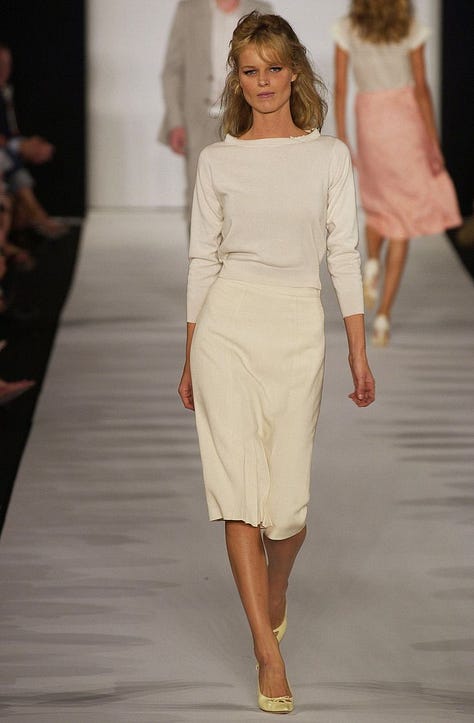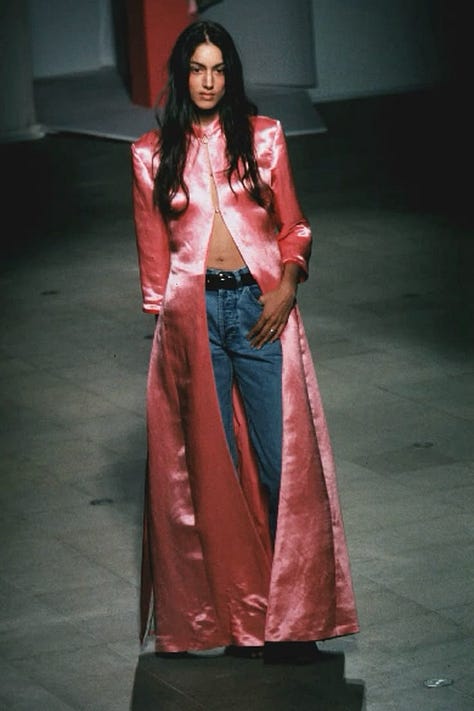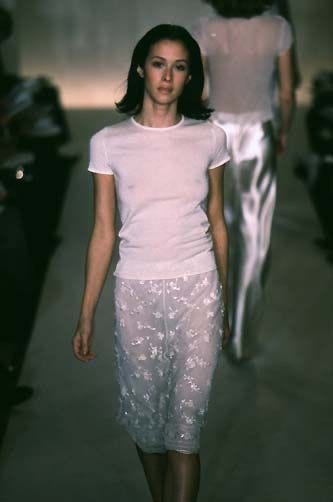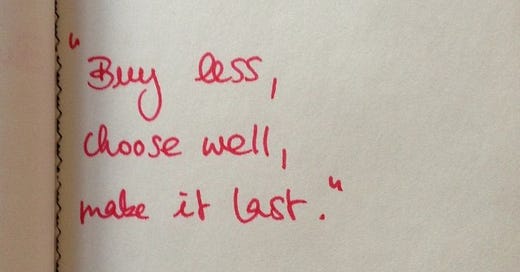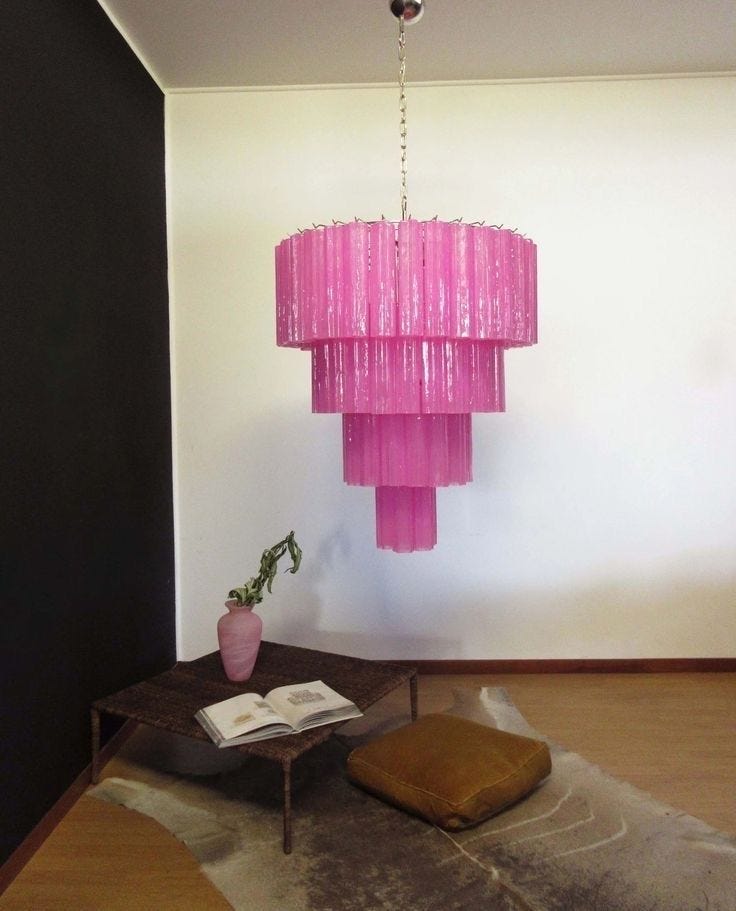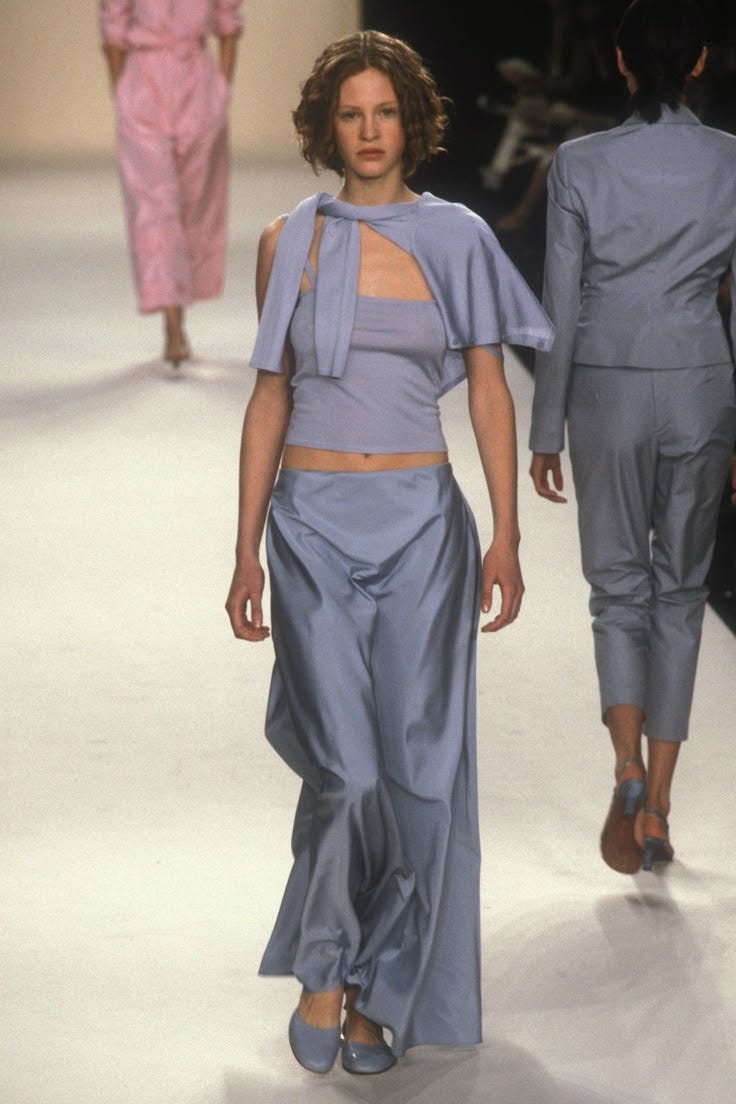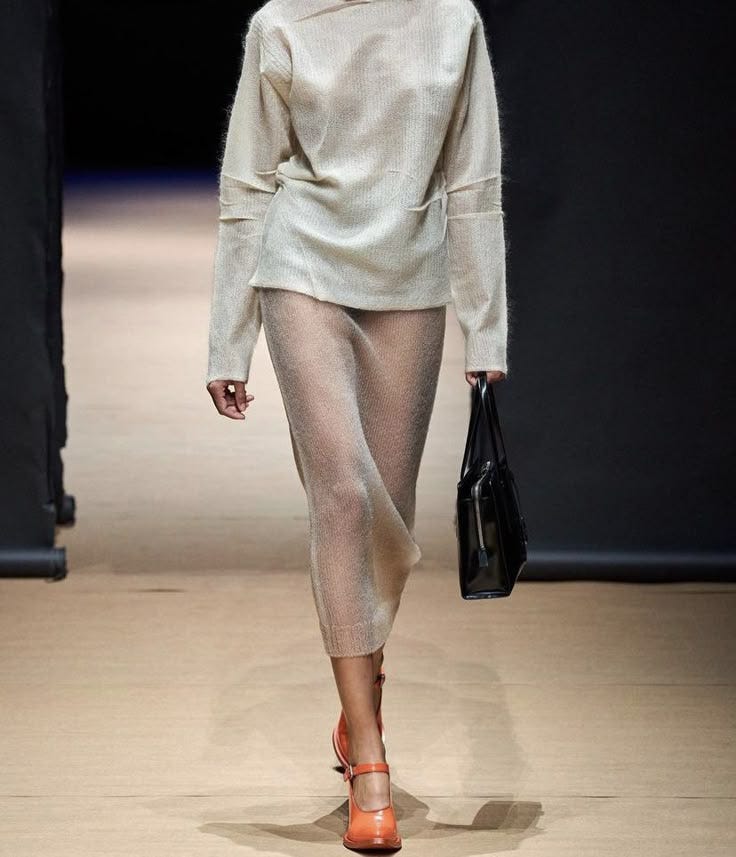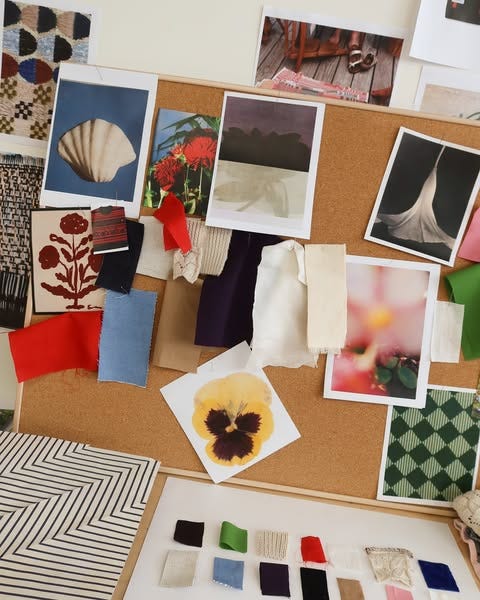No Buy Learnings
A year of buying less (mid-year check in) and other thoughts, investigations and feelings about shopping/consuming
In January I set some intentions and goals for the year, as we all do. I did the usual: walk more, prioritise cooking at home over uber eats, less (if any) alcohol, get better sleep; you know the drill. One area I had never set rules for (unless I was budgeting/saving for something) was around my fashion consumption.
I’ve seen friends - and also strangers - on the internet undergo “no buys” or “low buys” and loved the idea. I’ve also seen people set limits on how many new or secondhand items they can buy in a year. I loved this idea too.
So I set a challenge for myself - for January and February, I wouldn’t buy any fashion items. And when that was done, I would set some rules for the next 10 months of the year.
Without seeing others online take part in activities like this I don’t know if I’d have had the thought myself - the internet can be so fantastic sometimes. In sharing my own experience, I hope to inspire some of you to assess your own consumption behaviours (I don’t mean to sound preachy!). Given I also share a bunch of shopping recommendations and fashion content in other substacks/on the internet in general, I’m not here to lecture anyone! It’s all just food for thought. Not shopping for two months is nothing admirable but it’s definitely the beginning of consuming less.
I thought I’d be publishing this a few months ago - but life got in the way. However, having more time to assess this experiment I started in January, I think publishing this in June is definitely more beneficial. The 2 month experiment has impacted my year and continues to change and shape how I consume - which is, less and less.
In this substack you’ll find:
My background/shopping habits leading up to the No Buy
Unpacking the data and the emotional side of consuming
No Buy Learnings - what I loved about it/what I found hard
Is knowing your personal style the key to better/more conscious shopping practices?
Brands paving the sustainability way: Kowtow
Vivienne Westwood’s sustainability ethos
Let’s go back to January:
My background/shopping habits leading up to this:
For at least the last decade, I’ve tried my best to be a conscious shopper. This of course looks different for everyone. For me, when I’ve been able to, I’ve been investing in well-made, hopefully forever pieces. I haven’t bought from Zara, Kmart or H&M for years, I would never even look at Shein or Temu. But then, I do (sparingly) buy from Uniqlo, COS and I love an Arket shop when I’m overseas - does that still count as fast fashion? Yes. I also just bought pyjamas from Target…and I love them.
Fast fashion is of course an affordable option - and sometimes it’s the only option for people - whether that’s a budget thing, a size thing or for ease and accessibility. You need to do what’s best for you and your situation, I’m not here to judge!
When I buy, I look for things like:
good quality fabric, natural fibres preferred
am I going to be able to get a lot of wear out of it, for a long period of time?
what are the brand’s sustainability practices (I’m aware ‘sustainability’ is a broad term, more on this later)
On the other hand, fashion is FUN. It’s art. Styling is joyful. Playing around, adding new pieces into the mix - it can make your day and positively impact how you feel about yourself. It’s also a powerful way to express yourself. We all know that feeling of a fresh outfit, leaving the house in it, feeling on top of the world. It’s wonderful! And it makes sense why we would chase that feeling with each purchase.
I’ve always been an avid secondhand shopper - I grew up doing it with my nana and my mum, secondhand shopping is one of my greatest passions. But just because it’s preloved doesn’t mean I should be buying without deeper thought. All purchases should ideally be considered.
But for years I’ve found myself stuck with an always overflowing wardrobe. I’m no stranger to piles of clothing taking up space in various corners of my house. I’ve been steadily clearing out items - some for donations and some I’ve sold. My goal eventually is for everything I own to have a place and for my wardrobe to only have things I wear, year in, year out. But it’s a work in progress.
Unpacking the data and the emotional side of consuming
In a 2024 report it was revealed that Australia surpassed America as the world’s biggest consumer of textiles per capita - to put that in context to a number:
Australians buy an average of 56 new clothing items a year, more than the US (53), UK (33 items) and China (30). A large portion of what is being purchased is fast fashion and more than 200,000 tonnes of clothing end up in landfill each year, the equivalent weight of almost four Sydney Harbour Bridges.
Quite chilling, shocking stuff.
The report also suggests some great solutions to curb the fast fashion waste like incorporating a French-style fast fashion tax - whereby France will add a $16 tax to every ultra-fast fashion item sold. I’m unsure if that would prohibit buyers as Shein and Temu prices are already unbelievably low. Taxes on the actual makers and retailers would make more sense and perhaps the tariffs on China (where Temu and Shein are based) could see changes in consumer behaviour out of the US. But let’s not even get into the havoc those tariffs have done worldwide and to the fashion industry as a whole.
The report also suggests the move for:
Government-funded discounts for people who get old garments repaired
Federal investment to develop an Australian circular textiles industry
Greater support for community op shops and recycling initiatives.
So, why do we buy so much? Is it emotional? Are we bored? Impossible to please? Is it to trigger a sense of joy? Are we attempting to fit into a mold that we can never get quite right? We want to fit in? Stand out? Or satiate an appetite that can never seem to be sated completely? All are likely true at different times of our lives.
Individually we all need to look a little deeper and figure out why we feel a constant need for new, new, new, buy, buy, buy. There’s no way one person needs 56 new items a year, or even half that.
No Buy Learnings
So, how did the No Buy go? To be completely transparent, in my line of work I do get gifted things - so I did have a different experience to someone who doesn’t have that privilege. Whilst I do accept gifted items and clothing for work purposes I’m very particular with what I say yes to. There are more no’s than yes’s.
On January 2nd or 3rd I was out with my mum, wondering around Paddington and we happened to visit one of my favourite luxury preloved stores, Di Nuovo. I found a preloved Coach bag and needed it. This was my first test with shopping temptation and I failed. I used the excuse that this was my Christmas present from mum but that was a lie. From that day forward, my No Buy began. While it was a mental challenge initially, I really came to love the restriction of not buying.
I did have a rule that if I needed something for work or needed to replace something that broke/wasn’t functioning any longer, I could purchase - but throughout the two months, I didn’t end up cashing in on this.
Things that helped me:
Stop looking online and limit window shopping in person:
The less temptation, the better. Once I got into the groove of the No Buy, I found looking fun and inspiring.
When I saw things I was interested in, I started a wishlist - I used Carted for this:
I am going to do a separate Substack on all the items I added to my wishlist, how I feel about them now and what I’ve bought in the months since my No Buy ended.
What I loved about the No Buy experience:
It felt good not buying anything! It really helped me rewire my purchasing thought processes. I leaned into my closet at home and wore things I hadn’t reached for in a while.
It made me realise certain gaps in my wardrobe - ie a good blue shirt. It made me realise pieces I could part with, that I’d moved on from.
It made me realise I am an emotional shopper and often shop to fill the void. I thrive off the thrill of a new purchase and the rush of a great secondhand find or epic discount.
Overall, I felt such peace throughout my two months of not purchasing and the clear view it gave me of my habits. I loved ‘shopping my own wardrobe’. Not shopping almost became a game of its own - when March arrived, and I could resume buying I found I didn’t want to. I decided against buying a new formal dress for a black tie event I had and opted to re-wear something I already owned.
Is knowing your personal style the key to better/more conscious shopping practices?:
Social media is full of discourse around personal style. During my No Buy I spent time thinking of ways future me could shop smarter (namely less) and truly adore every thing I would spend my money on. What differentiates the pieces you love for years and years compared to the things you thought you would love but barely reach for? Sometimes the pieces you reach for year after year surprise you. You often don’t suspect an item is going to do that for you when you add to cart or you buy something you you’ll love for years, only to not reach for it after a few wears.
It really got me thinking - is the key to better buying, truly knowing your personal style?
In assessing the pieces that I wear over and over again, a large percentage of the stand out items I deeply treasure are secondhand (and therefore unique and different), hold a special memory from the time and place I bought them, they’re just really beautifully made or they’re the pieces that truly suit my lifestyle.
After years of shopping and accumulating things, getting to know what I feel good or special in and the pieces I return to - this has laid the groundwork for my personal style. This therefore makes it easier to identify things I love and will wear for years.
Of course what I love will evolve over the years but pinpointing things that will stand the test of time is getting easier.
Brands paving the sustainability way: Kowtow
We’ve all heard that shopping and wearing the clothes you own is the most sustainable choice. Is secondhand shopping the next best thing? Or is it shopping with brands that are working hard to close the fashion loop?
The end of my No Buy period fortuitously coincided with a trip to Wellington, New Zealand with brand Kowtow. While there I got an up close look at how Kowtow are doing things their own way and paving the way for sustainability in fashion.
The brand has all the hallmarks of sustainability; B Corp certified, use GOTS certified and fair trade organic cotton. They do third party auditing of their business, they share exactly where they source their materials from and the list goes on. You can read about everything they do here.
Here are some more stellar examples of their sustainability practices:
their whole range is entirely plastic free - and they have generously shared exactly how they achieve this so other brands can follow their blueprint if they desire.
launching their own repair program - customers can drop off or send their Kowtow pieces that need repair and the team will fix it free of charge.
once a buyer is finished with their Kowtow piece, instead of donating it - they can either send it back to Kowtow and sell via their relove initiative.
or if the piece has reached the end of it’s wearable life, Kowtow have incredible initiatives going in their Regenerate program and these donated items won’t end up in landfill. While at their head office I saw them using old cotton pieces and turning it into biochar, which was used to grow tomatoes.
Kowtow is a beautiful example of a brand doing things they don’t need to, but do because they feel ethically inclined to. They are the best example I know of, of true sustainability in fashion. I should add, what they produce is beautiful. I wear their pieces constantly, I love what they make and their sustainability practices only enhance their collections.
Gosia Piatek, the founder of Kowtow muses a lot on the idea of conscious expansion while trying to grow the business into international markets. This is always at the forefront of what they do. I saw firsthand how every single, tiny detail down to the shell buttons on their clothing to their flagship store design in Wellington is meticulously thought through.
I’d love to hear about any other brands you know that do similar things? They deserve all the love in the world.
I was also introduced to a brilliant not-for-profit group called Mindful Fashion New Zealand - a collective that assists, empowers and enlightens companies with better sustainability practices. Not all brands or companies can have their own sustainability experts in house, that’s where Mindful Fashion step in and assist.
Vivienne Westwood's impact:
While in Wellington with Kowtow we attended a Vivienne Westwood exhibit at Te Papa, followed by a panel called ‘Beyond the Runway: Fashion, Activism & the Environment.’ Kowtow’s founder Gosia spoke alongside other peers in the fashion industry - including former press officer for Vivienne Westwood, Olivia Jordan Cornelius - discussing Vivienne Westwood’s lasting impact and the urgent need for a fashion industry where business, people and nature can truly thrive.
Vivienne Westwood famously said, “buy less, buy well, make it last.” Olivia shared many stories and anecdotes of her time working alongside Vivienne. She talked about how Vivienne would ride her bike everywhere and would turn off the lights in the office all the time (even when the office was full of people). All of these small acts add up over time. She also shared that if you can’t necessarily “buy well” do your best to buy less and look after it.
Now that it’s June - I never ended up putting a structure around my buying once my No Buy lifted. I have purchased things (which I’ll share in part 2, alongside everything on my wishlist), most of which have been secondhand but these purchases have been few and far between. The No Buy has changed me as a shopper. It was the circuit breaker I needed. I am far more reserved, I stop before I purchase and most of the time walk away from buying. It’s become my year of buying less. It’s woken me up to my habits. This will continue to evolve over time and I’ll check back in at the end of year with further learnings.
More Smooth Brain Thoughts soon,
Ali x
